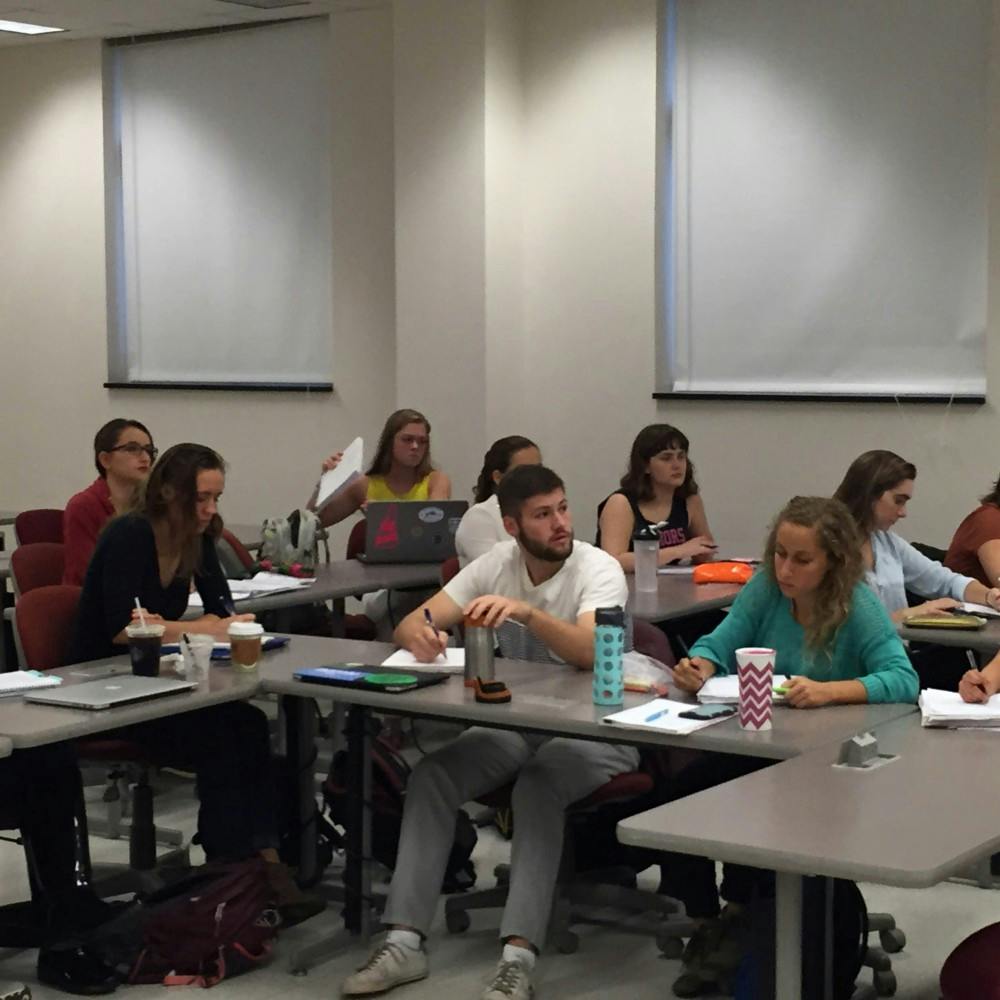If college chemistry departments are typically made up of a large male majority, it doesn’t show at Elon University.
Elon already has a strong female presence on campus with a roughly 60-to-40 male-to-female ratio, according to Elon Fact Book trends. And the chemistry department isn’t any different. Eleven of 18 majors listed in the Department of Chemistry are female.
“The science classes here are a lot more even [in terms of gender] than people would think,” said freshman and chemical engineering major Olivia Jung. “I thought coming in that it would be completely dominated by guys, but it’s more balanced than other majors might be.”
The numbers stand out when compared to the national averages. According to the National Science Foundation’s “Women, Minorities and Persons with Disabilities in Science and Engineering” report, 40.6 percent of physical science degrees were awarded to women in 2012, the lowest percentage since 2002. Physical science includes chemistry along with physics and astronomy.
“I have to take Elon’s gender ratio into consideration, but in terms of [physical science] interest at Elon, I would say that it’s pretty equal between girls and guys,” said senior and biochemistry major Alyssa Romano. “Actually, in one of my classes there’s probably about 13 girls and three guys, so it can be the opposite in some cases here.”
Romano added that female Millennials are getting more involved in the sciences than women in previous generations because of increased promotion. She said she noticed summer research internships she applied for were highly encouraging of women to apply, and the people she worked with in the Organic Chemistry Institute in Germany this summer were split evenly between men and women.

Elon gender numbers
In Romano’s field of biochemistry, the study of chemical processes in living organisms, this may continue — 28 of 38 listed biochemistry majors at Elon are female. The classes required for a biochemistry major are more chemistry-intensive than biology-intensive, according to Romano.
“Biochemistry is kind of what it sounds like,” she said. “It’s basically the chemistry of life, to understand organisms and what’s going on with them at a chemical level.”
The female majority in Elon’s biochemistry major is unusual, considering the gender gap in physical science knowledge as a whole. According to a Sept. 10 Pew Research Survey, men tended to answer more questions regarding physical science correctly than women. Men scored an average of 8.6 out of 12 in the survey, while women scored an average of 7.3. The survey found that 69 percent of men answered at least eight of the questions right compared to 51 percent of women.
“Men, on average, express greater course interest in the physical sciences than women,” Cary Funk and Sara Kehaulani Goo wrote for Pew Research Center about the survey’s findings. “This could in part explain the tendency for men to know the right answers to more of these questions, which focus mostly on the physical sciences, than women, even when controlling for educational level.”
Freshman chemistry major Jordan Diamond said the gap in scores could be because of how males and females are taught science differently at a young age.
“[Advancements] in science have historically been male-driven because of gender biases,” he said. “Women are told in school that men should be doing more math and science-related things, while women should be into literature and reading. Then people play into this gender role, which causes kind of a gap in learning.”
STEM learning in education
Solutions to the gender gap may lie in early education and how math and science are taught, according to senior education major Jenna Mason. She said society’s mentality is that boys and girls do well in different subjects with limited overlap, which leaves little opportunity for girls to develop an interest in STEM [Science, technology, engineering and math] topics.
“We really need to emphasize self-advocacy with STEM classes,” Mason said. “Right now, reading is so drilled into the minds of kids that there isn’t a lot of room for girls to explore math and science. That needs to change.”
Senior education major Angie Edwards agreed with Mason, saying elementary students are tested on literature more than the harder-to-grasp sciences. Part of that is because of the educators’ lack of expertise in STEM fields.
“Most of the educators for kids are female, and they aren’t always as confident in science and math as they are in other areas because of how gender roles are perpetuated,” Edwards said. “Science in general is more difficult to teach, so it can be kind of intimidating.”
But increasing the number of women educators in the physical sciences may instill STEM confidence for both genders instead of just men. A 2013 release by the White House Office of Science and Technology Policy said women earn 41 percent of PhD’s in STEM fields, but only make up 28 percent of tenure-track faculty. Romano said that number is growing.
“Over the past 10 years [the number of women in STEM] has definitely been going in a direction in which there is more women,” she said. “I think that it will continue to change because women are encouraged to apply for such positions and being accepted into those positions as well.”


